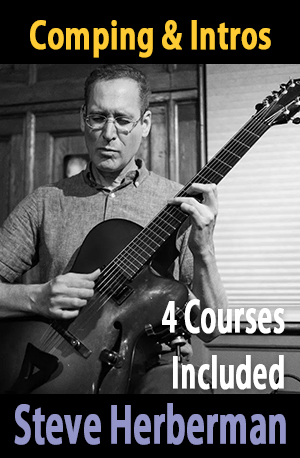Description
Comping and Intros Class Contents.
Comping Concepts Part One: 4/4 swing Class Content | Steve Herberman
In this class standards such as Stella By Starlight, In A Mellotone and Confirmation are used to demonstrate a variety of comping concepts applied to many different group formats a guitarist will find themselves playing in.
Concepts include:
- Essential tone (shell voicings), guide tone lines, pedal points, muti-use voicings (including rootless voicings), common tone, chromatic and stepwise voice-leading, Freddie Greene style, walking bass/comp, “over the barline”
- comping thru use of hemiolas, rhythmic “snare drum” comping, leaving space for a soloist while giving the soloist a solid “cushion”and overall techniques to help make a rhythm section swing.
Formats that will be discussed include:
- Guitar/bass duo
- guitar/voice
- and even comping for yourself while you are soloing!
| Comping Concepts Part One: 4/4 swing | |||
| Comping Concepts Part One: 4/4 swing | 01:30:00 | ||
Comping Concepts Part Two: Ballads and Jazz Waltz Class Content | Steve Herberman
In this second class on comping we’ll look at ballads and jazz waltzes and the types of comping that work well for each. Tunes will include My Romance, In A Sentimental Mood, Emily and West Coat Blues. On ballads, chordal fills will be demonstrated along with the integration of single notes and double stops in appropriate places backing the melody. Voice leading with usage of upper structure triads and passing chords will be shown using both rootless voicings and conventional drop 2 and drop 3 shapes. On jazz waltzes we’ll add aspects of rhythmic displacement and the use of half notes to create “over the bar line” phrasing. Also we’ll continue with essential tone comping and expanding the voicings to include extra notes. Some of the phrases that are included in the written examples are reminiscent of Ed Bickert and Jim Hall’s comping. Having a clear idea of voice leading through chord changes along with rhythmic diversity and swing, will make comping more effective, creative and fun!
View clips from Steve’s Class
| Comping Concepts Part Two: Ballads and Jazz Waltz | |||
| Comping Concepts Part Two: Ballads and Jazz Waltz | 01:31:00 | ||
Comping Concepts Part 3: Rootless Voicings & Chord Substitutions Class Content | Steve Herberman
Often guitarists will reach for chord ‘grips’ that have roots in the bass, sometimes out of habit. This can be effective when playing without a bass player, playing Freddie Green style rhythm guitar or Latin-style comping. On the other hand, it can be limiting in other contexts when a freer more harmonically rich approach is desired.
Rootless chord voicings, voice leading, and chord substitutions over standard tunes and modern jazz compositions will be the focus of this masterclass. Master compers like Jim Hall and Ed Bickert love to play clusters to get a more pianist sound adding interest to their voicings. We’ll examine many multi-use voicings that can get a lot of mileage in comping. Concepts outlined will include adding open strings to voicings, quartal voicings, and a variety of interesting comping rhythms. In order to freely use the upper structures of chords and substitutions, the chord theory has to be solid. We’ll get deep into the theory and discuss the reasoning behind substitutions that work. Also we’ll take a look at bossa comping, polychord reharmonization, and chord expansion techniques.
Written examples will include tunes or selected measures from: Come Rain or Come Shine, Windows, Desafinado, What Is This Thing Called Love and Gone With The Wind. TAB is included along with standard notation.
Learn to comp creatively and confidently while expanding your chordal vocabulary.
| Comping Concepts Part 3: Rootless Voicings & Chord Substitutions | |||
| Comping Concepts Part 3: Rootless Voicings & Chord Substitutions | 01:31:00 | ||
Artful Intros Class Content | Steve Herberman
If you are looking for both basic and new concepts to devise intros and endings, then this class is for you! The 16 pages of written material (including TAB) along with the 90-minute video will aid in learning the theory behind what makes great intros, beginning with the progressions themselves, and then many arrangements of rich chordal intros. Coming up with your own intros, both in practice and on the spot, is a fun and useful technique that can raise one’s level of overall musicianship. Once you are playing great sounding intros, you’ll always look forward to starting tunes!
Highlights of this class include:
- Chord substitution
- Common root motion
- Pedal points
- Sequential patterns
- Contrapuntal-style intros/endings
- Essential tone comping below melody
- Solo guitar style with a bass presence
- Specific examples meant to be used with bass accompaniment
- Guide tone lines
- Chord inversions
- 2 and 3-part chordal intros
- Single-note intros
90 minute video and written materials in standard notation and TAB for finger-style, pick-style and hybrid picking. After working through the class, you’ll never want to say “right on it” when counting off a tune again!
| Artful Intros | |||
| Artful Intros | 01:28:00 | ||



Reviews
There are no reviews yet.